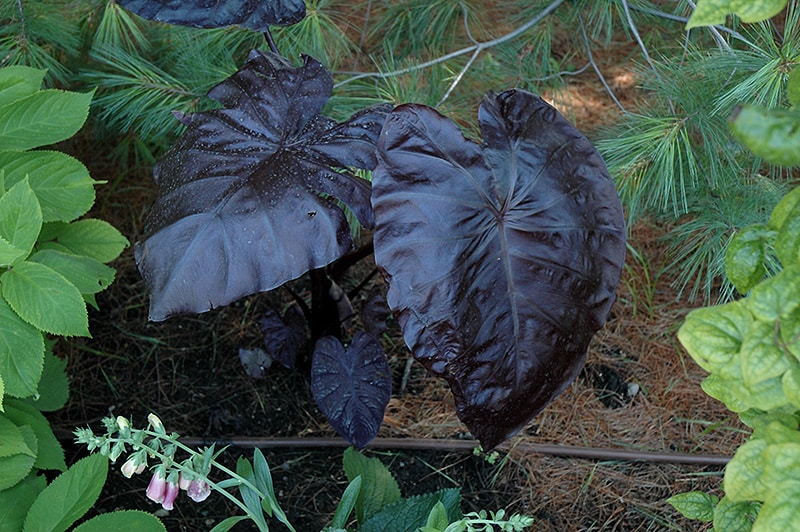Caring for Stunning Black Coral Elephant Ear Plants
The black coral elephant ear (Colocasia esculenta ‘Black Coral’) is an exotic looking plant known for its gigantic, glossy dark purple leaves. With leaves that can grow over 18 inches across, it’s easy to see where this plant gets its common name. Caring for these tropical beauties takes a bit of work but it’s worth it for the dramatic visual impact they provide.
Watering Black Coral Elephant Ears
Elephant ears need consistent moisture, especially when actively growing Allow the top inch or two of soil to dry out between waterings Provide around 0.5 cups of water every 9 days for a 5 inch potted plant that doesn’t get direct sun. Larger, in-ground plants need even more hydration. Water at the base of the plant and avoid getting water on the leaves. Elephant ears enjoy rainwater so allow them to benefit from natural precipitation when possible.
Soil & Fertilizer
Rich, moist soil is key to growing gorgeous elephant ear plants. They thrive in boggy conditions in the wild. Add compost or composted manure when planting and use a quality potting mix if grown in containers. Slow release fertilizer added at planting encourages strong growth. Most elephant ears are heavy feeders that benefit from regular fertilizing. Use a balanced liquid fertilizer every 2-3 weeks during the growing season for best results.
Sunlight Needs
Elephant ears flourish in full sun. In fact, the more direct sun they soak up, the darker the foliage becomes. Variegated types appreciate 4-6 hours of sun daily. Shelter from hot afternoon sun prevents leaf burn. If elephant ear plants don’t get enough light, the leaves yellow and plants decline. Place potted plants within 3 feet of a sunny window. Pick a spot with maximum sunlight if growing outdoors.
Overwintering Elephant Ears
Elephant ears can’t tolerate any frost. They die back completely in winter. In cold climates, you must dig up the tubers and store them over winter for replanting the following season. In fall, cut off the leaves, leaving about 12 inches of stem. Carefully dig up the tubers and wash off excess soil. Trim back roots and stems to around 3-4 inches. Place in cardboard boxes filled with wood shavings and store in a cool, dark spot around 50-60°F. Don’t allow tubers to dry out or freeze. Check periodically and discard any that start sprouting. Replant the tubers in spring after the last frost date.
Pruning & Maintenance
Pruning elephant ears improves their appearance and health:
-
Deadhead flowers as soon as they fade by cutting back to the main stem.
-
Remove damaged, diseased, or dead leaves as needed.
-
Cut off bent leaves damaged by wind.
-
Trim back overgrown plants in early spring.
-
Divide congested tubers every 2-3 years in early spring.
-
Provide stakes or shelter for potted plants to protect from wind damage.
-
Cautiously remove self-sown seedlings if they become weedy.
Troubleshooting Elephant Ear Problems
Elephant ears are relatively trouble-free if given proper care but may encounter:
Yellow leaves – Usually indicative of overwatering. Allow soil to dry out between waterings.
Wilting – Can be caused by too much or too little water. Check soil moisture.
Leaf spots/blight – Fungal disease exacerbated by wet foliage and humid conditions. Improve airflow and reduce watering.
Pests like aphids – Wash off with water or use insecticidal soap.
Slug/snail damage – Remove mollusks by hand and use baits if severe.
Rodent damage – Place hardware cloth around tubers when overwintering.
With their huge, dramatic leaves and tropical vibe, elephant ears make a stunning addition to gardens and containers. While they require some specialized care, following proper growing guidelines will keep your black coral elephant ears thriving season after season. With the proper soil, sun, moisture, and overwintering conditions provided, you can enjoy their bold beauty for years to come.
How to Plant Young Elephant Ear Colocasia Black Coral| Plug Plants Care| Black Leaf Elephant Ear
FAQ
Do black elephant ears need sun or shade?
How big do black coral elephant ears get?
How to care for a black coral plant?

